
Legal Education Review


|
Home
| Databases
| WorldLII
| Search
| Feedback
Legal Education Review |

|
TEACHING NOTE
Small Group Learning in Real Property
Law
ADIVA SIFRIS* & ELSPETH
MCNEIL* *
INTRODUCTION
In Techniques for Teaching Law, Hess and Friedland express their enthusiasm for “Seven Principles for Good Practice in Undergraduate Education” as valuable guidelines for legal educators.1
As committed legal educators,
the authors of this article are guided by these principles in their teaching
practice and believe that
“while traditional legal education emphasised
the acquisition of knowledge or ‘cognitive learning’, today
professional
legal education must seek to achieve other
goals”.2 If Law graduates are to be equipped with
lifelong skills and attributes then these goals must include the growth of
interpersonal
and communication skills in context throughout the undergraduate
degree.
The learning and teaching of real property law is a challenge for
both student and teacher. In accordance with the requirements of
the Victorian
Council of Legal Education, it is a compulsory subject in the law degree.
Students of Property Law, a core, full year
subject at Monash University, are
generally in the second or third year of their law degree and have completed a
small number of
law subjects.3 It is the first
conceptually difficult subject that students encounter in their undergraduate
degree and, as a result, Property Law
often has the highest annual failure rate
in Monash Law. Anecdotally, students embark on the study of Property Law with a
great deal
of apprehension and trepidation.
Traditionally, Property Law has
been taught by means of lectures, supported by tutorials. Students have also
been encouraged to study
in small groups as described below. Although the
tutorials provide a forum for interaction, discussion and problem-solving in a
medium-sized
group, the enrolments in each lecture stream and the size of the
lecture spaces needed to accommodate them are not conducive to encouraging
students to engage actively with the class and with the subject matter.
Assessment has traditionally been by examination or by examination
and research
assignment.
Against this background and in light of their respective
experiences as teachers of Property Law, the authors sought to improve student
attitudes to and the learning and teaching of Property Law as well as the
profile of the subject. They decided to pilot a small
group4 learning project that would implement principles
of good teaching practice and provide a team based, collaborative learning
environment
in which students of Property Law could gain confidence and learn
among their peers, engage in active learning5 and
extend their interpersonal and communication skills.
In this article the
authors will describe the objectives of and methodology utilised during the
“Small Group Learning in Real
Property Law” project and report on
the benefits and difficulties which both students and teachers encountered. The
results
of the authors’ empirical study will be analysed and when
necessary their own observations added. Case studies will be used
to illustrate
and support these findings. Finally the authors will reflect upon the
implications flowing from the data and draw some
conclusions regarding the
efficacy of small group learning in legal education.
OBJECTIVES
Jaques asserts that:
Teaching and learning in small groups has a valuable part to play in the all
round education of students. It allows them to negotiate
meanings, to express
themselves in the language of the subject, and to establish a more intimate
contact with academic staff than
formal methods permit. It also develops the
more instrumental skills of listening, presenting ideas and
persuading.6
The authors viewed the small group as
the ideal medium through which to achieve their goals in Property Law. It would
provide the
students with an opportunity to work and interact with one another
in small teams and to provide mutual support. As it was envisaged
that the group
tasks would have an oral as well as a written component, provision would be made
for different learning styles.
It was anticipated that administering and
guiding the groups would be particularly challenging given that 435 students
were enrolled
in the course. However it was thought that the ultimate benefits
for the students would far outweigh the daunting temporal demands.
THE PROJECT
The project was comprised of two components: Self-Learning Groups and
Research Assignment Syndicates.
The tutorial group was used as the vehicle
for the project. Tutorials in Property Law were conducted weekly. Each tutorial
group was
comprised of approximately 24 students. In previous years students had
been encouraged to form small study groups voluntarily from
within their
tutorial groups. These groups, known as Self-Learning Groups
(‘SLGs”), met fortnightly and discussed problem-based
material
provided by the Property teachers. The authors formally divided each Property
Law tutorial group into SLGs of four to six
students. Students were required to
register for an SLG and were given the opportunity either to form their own
group or to be placed
in a group with others they did not know. Prior to
registering students were advised that the SLGs would take collective
responsibility
for 30 per cent of the assessment of each student in
the SLG.
Self Learning Groups
A booklet was prepared with tutorial and SLG
problems, similar to examination questions and divided into weekly segments.
Topics corresponded
to those in the subject reading guide issued to all Property
Law students at the beginning of the year. Each SLG was expected to
meet weekly
at a time and place of its choosing to discuss the week’s problems. As the
problems were on the same topic as those
covered in the weekly tutorials it was
intended that the SLG material would supplement and reinforce the subject matter
covered in
that week’s tutorial.
During the course of the year, each
SLG was required to present two problems from the booklet to their tutorial
group, one in each
semester. The authors allocated the problems and each member
of the SLG was expected to contribute to both the preparation and discussion
of
the designated problem. Presentations were of approximately 15 minutes’
duration.
Assessment took into account each student’s tutorial
attendance (one per cent) and contribution to class discussion (one per
cent) as
well as preparation for and presentation of the two problems (three per cent), a
total of five per cent. Given the number
of components that made up this five
per cent assessment, it was highly unlikely that each member of the SLG would
receive an identical
mark. The minimal mark allocation for each component was
seen as an educational tool, encouraging students to attend tutorials and
to
participate in class discussion. Attendance at tutorials was not compulsory, but
a record of attendance was kept for each tutorial
group. This record indicated a
marked increase in student attendance at tutorials compared to previous
years.
Research Assignment Syndicates
It was intended that the SLGs would form the basis of
Research Assignment Syndicates (”RAS”) of four students. A number
of
those SLGs with four members automatically formed an RAS. Those students who
particularly requested to work with others who were
not in their SLG were
accommodated, provided that any “spare” members of the SLG were
accounted for. In the interests
of a harmonious working relationship between
members, in some cases the RAS were comprised of students across tutorial
groups.
In another extensive administrative exercise, the authors regrouped
the “spare” members as well as the SLGs with more
than four members
into syndicates7 of four for the purpose of completing
the research assignment. In a small number of cases, having regard to group
dynamics or to
preserve an SLG, syndicates of three or five were formed and on
two occasions special permission was granted for syndicates with
only two
members.8
There were two components to the research
assignment: a research strategy report, worth five per cent, describing research
methodology
and skills and a 2,000–2,500 word written assignment worth 20
per cent. The criteria for assessment of the written assignment
were content,
presentation, analysis and other legal skills. The students were required to
undertake the research work in their syndicates
of four, but were permitted to
write and submit the assignment either as a group of four or in pairs.
Learning objectives
One of the main motivational factors for introducing
small groups was the recognition of the importance of cooperative working among
peers with the resultant enhanced communication skills and tolerance of
divergent points of view. While these skills and attributes
are not specific to
Property Law and are important throughout the Law course, the authors saw the
project as an opportunity for the
creation of invaluable qualities and skills
that would help to equip students for life in addition to enhancing their
studies of
Property Law.
Some students may be intimidated by the prospect of
speaking in front of a large group but feel more confident about offering their
thoughts to a small group. Such an environment can also fulfil a desire for
social belonging, fostering motivation and learning.9
Students’ ability to “feed off” one another has both
positive and negative connotations. It encourages the sharing
of ideas and
drawing of inspiration from one another. The authors envisaged that the
convivial environment of the SLG would create
the appropriate forum for an
exchange of ideas and reflection on the problematic areas of Property Law. This
would in turn assist
students in their comprehension and appreciation of this
particularly difficult area of law. Those students who preferred working
on
their own could use the group setting to ventilate ideas and then consolidate
their views individually. A task might be divided
into a number of components:
for example, research, writing, proof reading and consolidation of the final
product. Each step can
draw on the particular skills of different members and
the end result is vastly superior to that which the individual member could
produce in isolation.
On the negative side, the authors envisaged a potential
problem with “freeloaders”10 and the
“outsider”. The code of ethics and work program were intended
largely to circumvent this issue.
Code of Ethics
Once assignment topics became available RAS members
were expected to conduct a preliminary meeting and design a code of ethics and
work program. This document was to be submitted to the Faculty by a specific
date. Students were encouraged to discuss difficulties
within the group with the
authors. A procedure was designed for use by syndicates experiencing problems
with a member who did not
comply with the RAS' code of ethics or work plan. The
participating members would be required to complete and sign a standard letter
setting out the breach and advising the non-participating member of expulsion.
The letter would then be posted to the non-participating
member and a copy given
to the authors. Subject to compliance with that procedure by a specified date,
an RAS would be authorised
to regard the non- participating student as no longer
being a member of the syndicate. That student would be required to submit a
separate assignment on the same topic independently and the expulsion itself
would not constitute grounds for special consideration
or an extension of
time.
Each member of the RAS was required to sign a written declaration
certifying that they either had or had not made a relatively equal
contribution
to the preparation and writing of the assignment and that they would accept an
identical mark. In the case of those
who certified that an equal contribution
had not been made an explanatory letter would be required to accompany the
declaration.
Interestingly no students availed themselves of this procedure
although the research indicates (see RAS difficulties below) that 10
per cent of
the students who responded to the questionnaire perceived that there had been an
unequal contribution from their syndicate
members. This is supported anecdotally
as a few students complained informally after having submitted their assignment
that some
group members had not contributed equally to the work and asked for
this to be taken into account in the assessment of the assignment.
Apart from
pointing out to students the important ethical lesson11
that they should not sign a declaration unless they believed in its truth, there
was nothing that could be done at that stage.
It
seems from this anecdotal information that the students in question were not
prepared to compromise 25 per cent of their assessment
by raising the issue
before submitting their assignment but were prepared instead to make a moral
compromise in making the declaration.
Other students may have had different
reasons for deciding not to declare and explain an unequal contribution, but
this information
did not emerge from the project.
Methodology
Throughout the project, it was intended that the
authors would evaluate the ongoing progress of the SLGs and RAS. After all
groups
had completed both tutorial presentations and the research assignment, a
detailed questionnaire was designed with the help of Monash
University’s
then Centre for Higher Education Development (CHED)12
and administered to Property Law students. 268 of the 435 students enrolled in
the subject, that is approximately 62 per cent, attempted
the questionnaire
which had separate sections relating to SLGs and RAS. The questionnaire was
voluntary and anonymous.13
The questionnaires were
administered with a view to improving student learning and the authors’
teaching as well as generating
ideas for alternative course presentation and
different teaching methods that would aid and enthuse students in their study of
Property
Law. The main aims of the questionnaire were to ascertain whether:
The questionnaire consisted of
17 straightforward questions divided into the two sections, relating to SLGs and
RAS respectively,
intended to ascertain student attitudes towards small group
learning in the two contexts.
Unfortunately, resources did not extend to
allowing the authors to obtain further qualitative research from student focus
groups.
Research Findings
When canvassed informally in tutorials prior to
experiencing small group learning in Property Law, many of the students seemed
to
have a positive view of working in small groups for tutorial presentations.
However, fewer students seemed to feel positive about
completing the research
assignment in groups.
Following completion of the formal questionnaire the
responses were analysed and produced some interesting results.
Self Learning Groups
The success of the self-learning group/tutorial project depended to a large degree on the frequency with which the groups met. Of the 252 students who responded to this question, only 27 (10.71 per cent) stated that they met regularly, on average once a fortnight. Of those who met more than twice during the academic year all group members attended meetings in only 56.76 per cent of cases. This figure would seem to be indicative of the logistic difficulties that students encountered and may serve to explain why generally the SLGs met infrequently. The benefits and difficulties encountered by the students are examined in further detail below.
Chart 1: Frequency of SLG Meetings
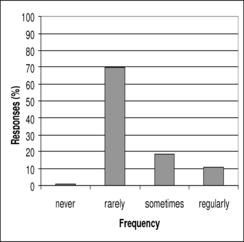
As shown in Chart 1, 70 per cent of the students responding to this question
met only rarely, that is one to four times during the
year, which suggests that
a number of SLGs may have met only to prepare their two tutorial presentations.
If so, this would seem
to reinforce the importance of assessment as a motivating
factor in the success of group working.14
However,
it is interesting to note that 79 per cent of the respondents thought that each
member of the SLG should receive an identical
mark for the tutorial
presentation. The most striking reasons for this conviction were:
When asked how they rated working in SLGs on a scale of one to ten, ranging from not helpful to extremely helpful, 10.5 per cent of respondents had strongly negative feelings about working in SLGs and only 2.7 per cent found the groups extremely helpful. However, a majority of students indicated that they found SLGs helpful: 73 per cent designated a rating between four and eight on the scale, with a noticeable concentration between five and eight. (See Chart 2.)
Chart 2: Rating for SLGs
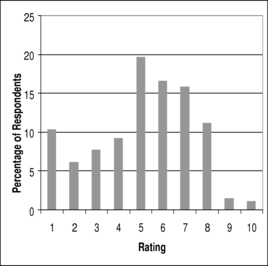
Division of work and co-ordination of the presentation
The students were asked to describe the method that
their SLG adopted for the allocation of work and co-ordination of the oral
presentations.
All students had been required to participate actively in the
presentation, but each group had been able to decide the basis on which
work
would be allocated to its members. Of those who provided information in response
to this question, some indicated the frequency
with which work was divided,
varying from 35.5 per cent who said that work was always divided among the
SLG members to 6.5 per cent
who stated that work was never divided up but was
undertaken individually. Other respondents described the basis on which work was
divided, for example to ensure equality of division, to accommodate group
members’ “comfort zones” or according
to the issues identified
in the problem. Yet others described both the frequency with which and the basis
on which work was allocated.
Observation of the presentations themselves
suggested that some SLGs had divided the preparation and presentation according
to the
different skills and learning styles of the group members.
While it
was disappointing that 12.3 per cent of the respondents allocated the work
haphazardly according to which SLG members were
present at the meeting at which
the division was made, it was pleasing to note the degree to which the students
were concerned to
ensure equality and satisfaction for all members of their
SLG.
Benefits
Respondents indicated that they derived a number of benefits from the experience of working in SLGs, 87 per cent finding at least one benefit associated with SLGs. Nine per cent of respondents left the question blank and only four per cent found no benefit.
Chart 3: SLG Benefits

The significant benefits were:
Difficulties
Ninety two percent of the respondents experienced at least one difficulty while working in an SLG. Difficulties ranged from “A greater risk of getting the answer wrong because there was no supervision” to “having to work at a group pace eg earlier or slower than would normally do work”. On analysis of the data the most frequently recurring difficulties fell into a number of categories in the following descending order:
Chart 4: SLG Difficulties
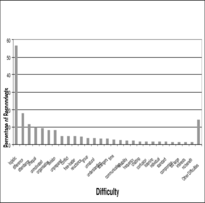
Research Assignment Syndicates
One hundred and ten syndicates were formed for the
research assignment. Interestingly, even though students were able to choose the
members of their RAS, only 51 per cent of respondents indicated that they chose
all RAS members with a further seven per cent choosing
some members. The
remaining 42 per cent were allocated to an RAS with other students in their
tutorial group.
Separately, students were asked whether all members of their
RAS and SLG were identical. Notably, 48 per cent of respondents reported
that
they were not and that students from different SLGs made up the RAS. Of those,
34 per cent would have preferred to be in an
RAS with members of their SLG
whereas 54 per cent would not and 12 per cent were undecided. Of those undecided
students, the majority
(62 per cent) were of the opinion that the composition of
the group made little difference.
Of those respondents who indicated a
preference for a syndicate comprised of their SLG members the main reasons given
were familiarity
with members and logistic arrangements.
The students were
also asked how they rated working in a RAS, again on a scale of one to ten
ranging from not helpful to extremely
helpful. It is interesting to note that
the distribution of ratings for RAS was significantly different from that for
SLGs. A smaller
majority indicated that they found the RAS helpful: 11 per cent
of respondents found RAS extremely helpful while at the other end
of the scale
19 per cent exhibited extreme dissatisfaction with group work in this form. The
other 70 per cent were spread more evenly
along the scale between two and nine.
The mean of 4.92 indicates that the student respondents had a negative reaction
to the RAS
and did not regard them favourably (see Chart 5.)
Chart 5: Rating for RAS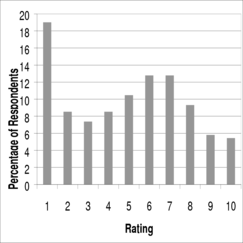
Division of Research and the Writing of the Assignment
Only eight per cent of respondents stated that they worked as a group for both the research and the writing of the assignment and read all the material and understood all aspects through collaborative discussion. Greater numbers worked in groups either for the research or the written components separately. Nineteen per cent of respondents combined in their RAS for researching the assignment whereas notably 37 per cent wrote the assignment in groups. Fifty nine per cent of respondents researched individually and 43 per cent wrote up the assignment on their own: in some cases one person alone reported having written the whole assignment and in others all members wrote separate sections that were then merged together. The balance of the respondents combined group and individual work throughout (Chart 6).
Chart 6: Research/Writing
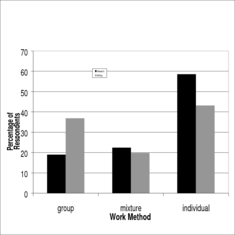
The student respondents described five main criteria for the division of assignment responsibilities and work:
Code of Ethics
Students were asked whether their RAS had adhered to its code of ethics: 69 per cent of respondents stated that they did while 31 per cent stated that they did not. Those who did not adhere to the code gave the following main reasons:
Of those respondents who did adhere to their code of ethics, 38 per cent found it to be a useful tool in group dynamics. The reasons offered for the utility of the code overlapped to some extent with the reasons given in relation to adherence. The main reasons articulated were:
Conversely, 62 per cent of the respondents who adhered to the code found that it was not useful.18 The main reasons for this conclusion were:
Benefits
The majority of respondents found at least one benefit in working in an RAS. Eight per cent could find no benefits and were left with only negative feelings towards group working and a further 15 per cent failed to give any response. For the 77 per cent who responded positively, the main benefits of collaborative working included:
Chart 7: Benefits of RAS
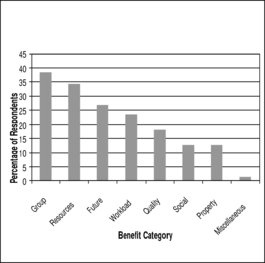
Difficulties
Disappointingly only one per cent of respondents expressly stated that there were no difficulties associated with working in an RAS whereas 91 per cent listed at least one difficulty. The six most prevalent difficulties were:
Chart 8: RAS Difficulties
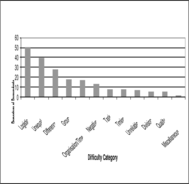
CASE STUDIES
The following case studies illustrate some of the different group dynamics, attitudes and challenges that were evident among the RAS during the project.20
|
Case Study 1 Anh, Bella and Charlie are three students who all embarked on their Law
studies as school leavers and are also friends. They attended
the same Property
Law tutorial group and formed an SLG. Digby, a mature age student with other
responsibilities in addition to study,
was added by the project co-ordinators as
the fourth member of the SLG. The members of the SLG also constituted an RAS.
The members
of the group worked well together for their first oral presentation
but encountered difficulties with the research assignment. Prior
to commencing
work on the assignment, the students had completed a code of ethics setting out
their work plan and ethics.
However, once work started, the younger students expressed concern about Digby’s participation, claiming that he did not attend group meetings or arrived late and that if he did complete his share of the work, it was not of an acceptable standard. In turn, they found him to be critical of their contributions. The three younger students seemed anxious that Digby’s perceived lack of commitment would affect the final product and assignment result. An attempt was made by Property teachers to mediate between the parties and they were encouraged to discuss the perceived difficulties. However, unfortunately the situation deteriorated and it became obvious that the other three students no longer wanted Digby as a member of the RAS. These feelings were not mutual and he wanted to remain in the RAS. Co-operative work became impossible and the expulsion procedures were utilised. Digby was offended when he received the expulsion notice and thought that the other group members could have been more understanding of the other demands on his time. He considered it to be unfair that he was then obliged to submit an assignment on his own. However, it had not been possible to resolve the matter amicably within the time constraints for submission of the assignment. The final tutorial presentation was made as a “group” but it was apparent that there were tensions and the group was fragmented three:one. |
Comment
This example of some of the challenges of group work illustrates
the fact that, while “group work can have a positive impact
on students in
a variety of ways”,21 it can lead to conflict
between members and can have a negative impact on some
students.22 While their concerns may have been
legitimate, it is also possible that the younger students were abusing the
expulsion procedure
and that the mature age student was treated unfairly.
Was
there a better way to handle the situation? Could the authors have supervised
the implementation of the work plan and group meetings
and overseen the work to
make sure everyone was contributing fairly? This was considered to be too
intrusive and as defeating the
purpose of team work and group learning. The
authors were also conscious of the importance of the students taking
responsibility
for their own learning. Another consideration was the
“domino effect” and how other syndicates having difficulties would
respond to this intervention. Furthermore, it was considered that it would be
resource intensive and time consuming; the time could
be spent more productively
in other ways.23
|
Case Study 2 Emilia and Fergus were friends but, due to time- tabling, were in different
tutorial groups. They requested that they be in the same
RAS but had no
preference for the other two syndicate members. Gilda, a full-time student, and
Hans, a mature aged, part-time student,
were added to complete the
syndicate.
Shortly after the group’s code of ethics had been finalised, work commitments sent Hans out of the metropolitan area. While the authors were made aware of the situation, the other members of the RAS decided they could communicate with Hans by telephone, email and facsimile transmissions to complete the assignment. Unfortunately, however, Gilda suffered a succession of health problems and was unable to keep pace with group commitments. The syndicate made every effort to include her but eventually approached Property teachers with the problem. In the circumstances it was decided not to use the formal expulsion procedures. Gilda was given permission to submit a separate assignment and was also granted special consideration. The long distance arrangement worked for the remaining syndicate members and Emilia, Fergus and Hans submitted a combined assignment. |
Comment
Again there were challenges, but this RAS should be viewed as a
success. The fact that the long distance working relationship succeeded
is a
tribute to the determination and commitment of the three remaining RAS members.
One must question, what was the bonding factor?
The two initial group members
were friends, but apart from the code of ethics and work plan and the fact of
having been placed with
Gilda and Hans they owed the other two RAS members no
allegiance. Arguably it would have been easier for them to break away and submit
their own assignment. However they chose not to and they worked to complete the
assignment under difficult conditions.
Gilda’s situation was handled
with as much sensitivity as possible. With the additional time and special
consideration, she
was able to complete not only the assignment but also the
subject Property Law that year. Were it not for the other group members,
staff
may not have been aware of the difficulties and she may simply have
“dropped out” of law school.
|
Case Study 3
Imran, Jasmine, Katerina and Lee were long-standing friends in the same
tutorial group who formed an SLG and RAS. While the students
were in the throes
of their research assignment, a member of Imran’s family became critically
ill. It was difficult for him
to concentrate effectively on the task at hand and
he foreshadowed a possible request for an extension of time. The other members
of the group made a joint decision to support Imran unconditionally. They
provided him with both practical and moral support and
the assignment was
submitted on time.
This syndicate received a high mark for their work. The assessor had no idea of the history behind the assignment. The group members remain friends. |
Comment
This is an example of group work at its best. Left to his own
devices Imran may not have submitted an assignment on time, if at all,
and it is
unlikely that the work would have been of the same quality. However, with the
support and assistance of his friends and
fellow RAS members, the assignment was
completed to a high standard and all were very happy with the result.
Does
this mean that a foundation of existing friendship is necessary for a successful
small group or can group members who did not
know each other previously develop
the necessary skills to cope in such a situation? While friendship was
apparently an important
factor in Case Study 3, Case Study 2 suggests that a
small group can operate successfully in other circumstances. The team
environment
allows for the development of peer support, cooperation and
collaboration, providing reciprocal and mutual benefits for all members.
REFLECTIONS
Expectations
When the idea of small group learning was introduced to students, the
information provided was sparing and in general
terms.24 With hindsight, and with the benefit of the
insight provided by the case studies,25 it would have
been preferable for additional and more specific information to be available to
students to provide them with a firmer
foundation for drafting of a more
detailed code of ethics and for better mental preparation for the tasks
ahead.
Apart from division of the tutorial groups into SLGs and RAS as
described above, minimal structure and direction was provided for
the students.
The students were given the independence, responsibility and flexibility to
co-ordinate the frequency and modus operandi
of their own group meetings.
Feedback was provided to students about the content of their research
assignments and group presentations. However, the authors offered
little input
about or evaluation of the groups’ working as a team or the division of
tasks. Students were thus offered little
guidance on how to operate within the
group rather than as an individual, but generally seemed to develop the teamwork
skills required.
Interaction
The authors believed from the outset that in order
for groups to work effectively a “bonding factor” is required.
Generally,
one cannot group four strangers and expect them immediately to bond
and work together.26 The students “must connect
to form an effective working group”.27 Therefore
the SLGs were formed to allow the students to become acquainted and develop a
working relationship in preparation for their
tutorial presentations and
especially for their research assignments. Unfortunately, however, some of the
SLGs met on only one occasion
prior to combining for an RAS and in other cases
students were in an SLG and RAS comprised of different members. The number of
SLGs
that did not team up as an RAS but elected instead to undertake the
research assignment with other students surprised the authors.
Case Study 3
illustrates that years of friendship can be one of the bonds that holds a group
together, both as an SLG and as an RAS.
Case Study 2 is more puzzling: perhaps
one can attribute the cohesiveness of the group to a moral bonding founded on
the code of
ethics in addition to the development of interpersonal and
communication skills.
Apart from those few groups in which the expulsion
procedure was utilised, having completed the research work as a whole group the
vast majority of RAS chose to continue with the writing and submission of the
assignment also as a whole group. Notably only three
syndicates elected to
divide into pairs for the writing and submission of the assignment.
In
addition to the interaction that the students described in their responses to
the questionnaire, the authors also observed other
features. In particular, it
was noticeable that some of the SLGs sat and socialised together in tutorials,
either as a whole group
or as part of a group. This occurred regularly for some
groups and occasionally for others. In some instances this started from the
beginning of the year as the students were already on friendly terms and had
formed their own SLG, but in other instances this was
a phenomenon that
developed as the year progressed and the students became better acquainted and
developed their interpersonal skills.
The social aspect of small groups is
recognised as an important factor in enhancing
learning.28
Similarly, the authors also observed
some apparent difficulties that were not mentioned in the responses to the
questionnaire. Students
were allocated to SLGs (and RAS) without regard to
gender or age, with the result that there were different proportions of male and
female or mature-age and younger students in different groups. Generally this
did not cause any problems, but Case Study 1 illustrates
some of the tensions
that arose when expectations and other commitments differed between a mature-age
student and the other group
members who were younger. In one
group29 of three female students and one male student
tension developed along gender lines during the preparation and writing of the
assignment
and this carried over into the SLG and was apparent in tutorials. In
other examples, students requested tutorial changes on the basis
of alleged
timetable changes, but it appeared that the real basis was difficulties within
their SLG.
Learning
Pedagogically the small group, team based approach is a sound one. As the respondents reported, it provides students with an opportunity to share information, opinions and ideas through in depth discussion as well as to interact and communicate with one another in an environment of mutual support. This co-operation and pooling of resources in turn can lead to a greater understanding of the subject matter and improved study techniques and problem solving skills. Students can also acquire or develop interpersonal skills including the ability to communicate, compromise and co-operate in a group.
Self Learning Groups and Research Assignment Syndicates: Comparisons and Contrasts
There was some commonality between the top SLG and
RAS benefits identified by the students: sharing of opinions and discussion;
sharing
of workload; acquisition of interpersonal and academic skills; social
interaction; and increased understanding of Property Law. The
difficulty that
stands out for both forms of small group work is logistics and is one of the
variables encountered in group work
that are generally beyond the control of the
teacher.30
However, overall students had a more
positive view of SLGs than the RAS. Perhaps the relative weighting of these two
components of
the year’s assessment was significant. While only five per
cent was attributable to tutorial participation and the SLG oral
presentations,
it was apparently enough to induce the students to participate in their SLG at
least twice throughout the year. The
more motivated students, perhaps in more
successful groups, met more frequently and arguably experienced more of the
benefits of
small group learning.
The RAS were a different matter and
elicited more extreme reactions from the students. The authors believe that an
important factor
in this was the relatively large proportion of the year’s
assessment that depended on the performance of the RAS. As the case
studies
show, this brought out both the worst and best in syndicate members.
SOME CONCLUDING COMMENTS
Le Brun and Johnstone describe “[t]he consequences of commodifying
education” and the potential drawbacks to which this
exposes the
university system.31 A delicate balance is thus
required between pedagogical considerations and catering to student
demands.
After considering the research findings and student reactions and
affirming the “Seven Principles for Good Practice in Undergraduate
Education” with which this article commenced, the authors are of the
opinion that it is worth continuing with and promoting
SLGs but not
RAS.
Notwithstanding the benefits of the RAS identified by respondents, in
light of the nature of the difficulties experienced and the
relatively high
proportion of the students’ annual assessment attributable to this
component and given that the average reaction
was negative, it is hard to
justify the continued use of the RAS. Conversely, despite the range of
difficulties associated with the
SLGs, in light of the nature of the benefits
gained and given that the average reaction was more positive, the authors
believe that
SLGs should continue.
However, given that administering SLGs and
oral presentations is also extremely time consuming and resource intensive, it
may not
be feasible to maintain small group learning in the form described. Even
if it is not possible to continue with SLGs on a formal
basis, students of
Property Law are still encouraged to form and work in SLGs informally as
before.
The authors remain committed to promoting the benefits of small group
learning and fostering an environment in which co-operative
and collaborative
learning32 are
encouraged.33
* Lecturer in Law, Monash University.
** Assistant Lecturer in Law, Monash University.
This research was supported by a Monash Law
Teaching Innovations Fund Grant, which is acknowledged gratefully. The authors
also gratefully
acknowledge the invaluable assistance provided by their research
assistant, Jennifer Whincup in the collection and analysis of data
for this
article.
©2003 (2002) 13 Legal Educ Rev 189.
1 GF Hess & S Friedland, Techniques for Teaching Law (Durham, North Carolina: Carolina Academic Press, 1999) 15-16.
2 A Greig, Student-Led Classes and Group Work A Methodology for Developing Generic Skills [2000] LegEdRev 3; (2000) 11(1) Legal Educ Rev 81.
3 Students have usually completed the core subjects of Legal Process and Criminal Law and Procedure and have either completed or are undertaking concurrently the core subjects of Contract and Torts.
4 Leveson, for example, notes that there is “no unambiguous definition of small group work” but that “there is general agreement that effective small group teaching and learning is student-centred”. L Leveson Small Group Work in Accounting Education: an evaluation of a programme for first-year students (1999) 18 (3) Higher Education Research & Development 361, at 362. Gerlach states that “Collaborative learning is based on the idea that learning is a naturally social act in which participants talk among themselves. It is through the talk that learning occurs.” JM Gerlach, Is This Collaboration?, in K Bosworth & S Hamilton eds, Collaborative Learning: Underlying Processes and Effective Techniques (1994) 59 New Directions for Teaching and Learning 5, at 8.
5 McInnis observes that “What makes a small group is the nature of the process of teaching and learning that takes place. Small group teaching is essentially a highly active learning experience for all participants, and assumes that students clarify their thoughts by talking.” C McInnis, Small Group Discussions, at Centre for the Study of Higher Education, University of Melbourne, <http://www.cshe. unimelb.edu.au/teachlearn1.html> (last accessed 22/09/02) (copy on file with authors).
6 D Jaques, Learning in Groups, 2nd ed, (London: Kogan Page,1991) 9.
7 Le Brun & Johnstone describe syndicates as “small, teacherless groups of four to six students. Students are set a clear task, topic, or problem, and then left to analyse and synthesise the relevant material or solve the problem on their own but within a supportive group environment.” M Le Brun & R Johnstone, The Quiet (R)evolution: Improving Student Learning in Law (Sydney: The Law Book Company Ltd, 1994) 294.
8 In one instance the two students wished to complete the research assignment early due to overseas travel plans and in the other instance the two students had special study needs.
9 Le Brun & Johnstone, supra note 7, at 292
10 Slavin emphasises that, while co-operative learning has potential benefits, it “can allow for the ‘free rider’ effect, in which some group members do all or most of the work (and learning) while others go along for the ride. The free rider effect is most likely to occur when the group has a single task, as when they are asked to hand in a single report ...”. RE Slavin, Cooperative Learning: Theory, Research and Practice 2nd ed (Massachusetts: Allyn & Bacon, 1995) 19.
11 Le Brun & Johnstone contend that “If we do not emphasise the ethical aspects of law to our students, they may fail to see the parameters of moral action in the practice of law. The more aware our students are of the moral content of the law, the more likely they will behave more appropriately.” Le Brun & Johnstone, supra note 7, at 397.
12 CHED is now the Higher Education Development Unit (HEDU) of Monash University’s Centre for Learning and Teaching Support (CeLTS).
13 As the questionnaire was voluntary and anonymous, it is not possible to determine how many SLGs and RAS were represented by the individual respondents. It should also be noted that not all respondents provided an answer to every question.
14 “Assessment is the most powerful lever teachers have to influence the way students respond to courses and behave as learners.” G Gibbs, Using Assessment Strategically to Change the Way Students Learn, in S Brown & A Glasner eds, Assessment Matters in Higher Education (Buckingham: Open UP, 1999) 41.
15 Leveson notes that “Discussion facilitates learning, not only because it is an inherently motivating activity but also because the very process of helping others is one of the best ways of learning.” L Leveson, supra note 4, at 363.
16 This contrasts with the finding by Zariski in a survey of Law students undertaking group work that 83 per cent of respondents stated that all group members had not contributed equally to the project. A Zariski, Lessons for Teaching Using Group Work from a Survey of Law Students, in R Pospisil & L Willcoxson eds, Learning Through Teaching 361-66, Proceedings of the 6th Annual Teaching Learning Forum 1997 (Perth: Murdoch University, 1997). However, Zariski’s survey asked the students directly in question 27 to tick “yes” or “no” in response to the statement that “My experience of group work has been that all group members contribute equally to the project” whereas the questionnaire in this study asked students more generally in question 3(b) to list three difficulties experienced while working in an SLG.
17 For example, in one group two members did the research, one wrote a draft and the remaining member edited the assignment.
18 This suggests that there may be a need for guidelines or examples to assist students in understanding the purpose of and then drawing up a code of ethics.
19 Zariski also found that, of the objectives of the course co-ordinators in setting group work, the three that the student respondents regarded as most relevant to them were co-operation, dispute resolution skills and organising. Zariski, supra note 16, at 364.
20 The names and some personal details have been altered to preserve anonymity.
21 A Zariski, Positive and Negative Impacts of Group Work from the Student Perspective in Murray-Harvey and Silins eds, Advancing International Perspectives, Proceedings of the Higher Education Research and Development Society, Volume 20 (Adelaide: Higher Education Research and Development Society, 1997) 778, at 780
22 Id at 779.
23 Chang asserts that “conflict must be effectively handled if it is not to be a barrier to progress” and that “conflict is best handled by managing it and adopting appropriate strategies to bring about a desired end". V Chang, How Can Conflict within a Group be Managed?, in K Martin, N Stanley & N Davison eds Teaching in the Disciplines/ Learning in Context, Proceedings of the 8th Annual Teaching Learning Forum, (Perth: UWA, 1999) 59-66. Joughin & Gardiner observe that “Facilitating independent learning involves increasing students’ responsibility for and control of their own learning...’Independent learning’ refers to learning which seeks to substantially increase student control of learning and which is substantially independent of the presence of a teacher. The teacher sets the parameters for learning and provides required resources while the student, or groups of students, controls the time, place and pace of their learning.” G Joughin & D Gardiner, A Framework for Teaching and Learning Law (Sydney: Centre for Legal Education, 1996) 60. However, they observe also that “Staff training in small group skills is often beneficial”. Id at 58.
24 At this early stage the authors were themselves to some extent unaware of the potential benefits and difficulties.
25 See in particular Case Study 1.
26 Miller, Trimbur & Wilkes note that “The personal and working relationships within the small groups can either make or break the course experience for many students.” J Miller J Trimbur & J Wilkes, Group Dynamics: Understanding Group Success and Failure in Collaborative Learning in K Bosworth & S Hamilton eds, Collaborative Learning: Underlying Processes and Effective Techniques (1994) 59 New Directions for Teaching and Learning 33, at 34.
27 Id, at 40.
28 McInnis, supra, note 5, at 2.
29 Used here as an anecdotal example and not as a case study.
30 Miller Trimbur & Wilkes identify variables including institutional or situational constraints such as timetabling, social calendar and physical space as being beyond a teacher’s control. Miller Trimbur & Wilkes, supra, note 26, at 40.
31 For example, the increasing student demands on academic and administrative staff which, if ignored, may affect students numbers or standards of excellence. Le Brun & Johnstone, supra, note 7, at 25.
32 Tang distinguishes between co-operative learning, initiated by teachers and collaborative learning, initiated by the students themselves. C Tang, Effects of Collaborative Learning on the Quality of Assignments, in B Dart and G Boulton-Lewis eds, Teaching and Learning in Higher Education (Melbourne: Australian Council for Educational Research Ltd, 1998) 102.
33 “To maximise the effects of collaborative learning, teaching should provide support and create a context to facilitate group learning.” Tang, id at 120.
AustLII:
Copyright Policy
|
Disclaimers
|
Privacy Policy
|
Feedback
URL: http://www.austlii.edu.au/au/journals/LegEdRev/2002/10.html